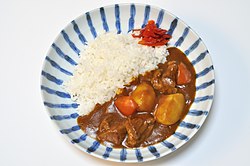日本のカレー
| 日本のカレー | |
|---|---|
 和風カレーとライスのプレート | |
| 種類 | カレー |
| 発祥地 | 日本 |
| 提供時温度 | 熱 |
| 主な材料 | 野菜 (タマネギ、にんじん、ポテト), 肉 (牛肉、豚肉、鶏肉) |
| 派生料理 | カレーライス、カレーうどん、カレーパン |
日本のカレー(karē)は、主に3つの形で供される。カレーライス (カレーライス, karē raisu)(カレーを白米にかけたもの)、カレーうどん (カレーうどん, karē udon)(太い麺にカレーをかけたもの)、そしてカレーパン (カレーパン, karē pan)(カレーを詰めたパン)である。これは日本で最も人気のある料理の一つである。非常に一般的なカレーライスは、最も頻繁に単に「カレー」 (カレー, karē)と呼ばれる。
ソースと共に、様々な野菜や肉が日本のカレーに使われる。基本的な野菜は玉ねぎ、人参、ジャガイモである。牛肉、豚肉、鶏肉が最も人気のある肉の選択肢である。カツカレーは、パン粉をまぶして揚げたカツ(とんかつ、通常は豚肉か鶏肉)に日本のカレーソースをかけたものである。
カレーはインド料理に由来し、イギリス人によってインドから日本にもたらされた。カレーの導入以来、日本の味覚と食材に合わせて再発明された。日本のカレーは他の地域のカレーとはほとんど似ていない。この料理は導入以来非常に変化し、適応したため、独自の日本料理として確立されている。甘くてねばり気のある日本の短粒米ととろみのあるカレーソースの組み合わせが、日本カレーの独自の進化を導いた。この料理は1960年代後半に人気を博し、スーパーマーケットやレストランで購入できるようになった。非常に広く消費されているため、「国民食」と呼ぶことができる。
歴史
日本のカレーの黎明期

カレーは明治時代(1868年-1912年)に日本に伝わった。当時、インド亜大陸はイギリスの植民地支配下にあった。イギリス人がカレー粉と呼ばれるスパイスミックスを日本に持ち込んだ可能性が高い。それは西洋からもたらされたため、洋食に分類された。カレーという言葉は、日本が鎖国を解き、大英帝国と接触を始めた1860年代後半に、日本語にkarēとして取り入れられたと思われる。1870年代には、日本でカレーが提供され始めた。
日本ではカレーは一般的にご飯料理として食べられ、karē raisu(カレーライス)と呼ばれる。raisu karē(文字通り「ライスカレー」)という料理について日本で最も古い記述は、1872年の料理本にある(ただし誤ってtaisu karēと表記されている)。1872年の報告書にも記載されており、それによるとお雇い外国人が北海道庁の東京支庁でこれを食したという。しかし、この言葉は1877年に札幌農学校(現在の北海道大学)に雇われたアメリカ人教授ウィリアム・S・クラークによって広められた。1873年には、陸軍士官学校のメニューにカレーライスという料理があった。
明治時代(1868年-1912年)には、カレーは民間ではまだ裕福層向けの高級料理と認識されており、高級な洋食専門店でしか味わえなかった。導入以来、日本の味覚に合うように日本料理の食材を使って再発明された。
カレーの普及と派生料理の登場

1905年、国産のカレー粉が導入されたことで、この料理は一般の人々にも手頃な価格になった。1920年代には、今日の有名企業であるエスビー食品とハウス食品の前身が粉末カレー粉の販売を開始した。
1900年代初頭、レストランはカレーライスの様々な派生料理を生み出した。最初のカレーうどんとカレーそばは、1904年または1909年に東京または大阪で作られた。カレーうどんやカレーそばは、鰹節(乾燥カツオの削り節)を熱湯に浸してうま味成分を溶かし、その出汁にカレーを加え、さらに片栗粉でとろみをつけてうどんやそばにかけるものである。
最初のカレーパン(karē pan)は1927年に、最初のカツカレーは1918年、1921年、または1948年に登場した。
家庭料理としての普及
1945年にオリエンタル株式会社が粉末即席カレールーを開発し、1950年にはベル食品株式会社が固形即席カレー風味調味料を開発したことで、日本のカレーは家庭で手軽に作れる料理として日本中に急速に広まった。1948年には、日本のカレーが初めて学校給食に採用された。
1963年、ハウス食品はリンゴとハチミツを使った即席カレー風味調味料「バーモントカレー」を発売し、爆発的な人気を博した。この商品は、辛い大人の料理と認識されていた日本のカレーにマイルドな甘味をもたらし、日本のカレーを子供たちのお気に入りの料理の一つにした。

1968年(または1969年)、大塚食品は世界で初めてレトルトパウチ食品の市販化に成功した。その商品は「ボンカレー」という日本のカレーであった。カレーは長期保存が可能になり、インスタントラーメンのように熱湯をかければ3分で食べられる食品となった。軍事技術であったレトルトパウチの詳細な技術情報は公開されていなかったため、大塚食品は高温殺菌技術を用いて点滴薬剤を開発していたグループ会社と協力して開発を進めた。
今日、カレーは日本で最も人気のある日常的な料理の一つである。2013年には、カレー粉の生産量が7,570トン、レトルトソースが91,105トンに達した。2008年の売上高は、カレー粉が70億円、レトルトソースが860億円であった。2000年までに、カレーは寿司や天ぷらよりも頻繁に食べられる食事となった。
インド亜大陸で提供されるカレーに似たカレーは、「中村屋カレー」として知られている。これはラス・ビハリ・ボース(1886年-1945年)が東京のパン屋であるNakamura-yaでカレーを販売し始めた際に日本に紹介されたものである。
ソースミックス
カレーソース (カレーソース, karē sōsu)は、調理された米の上にかけられ、カレーライスとなる。カレーソースは、カレー粉、小麦粉、油、その他の材料を一緒に炒めてルーを作り、そのルーを煮込んだ肉や野菜に加え、とろみがつくまで煮込むことによって作られる。圧力鍋を使用することもできる。
日本の家庭では、カレーソースはブロック状や粉末状のインスタントカレールーから作られるのが最も一般的である。これらにはカレー粉、小麦粉、油、様々な香料が含まれている。インスタントカレーミックスは、その手軽さ、多様性、入手しやすさから非常に人気があり、他の多くの日本料理と比較して簡単に作ることができるため、カレーライスは非常に普及した。調理済みのカレーは、熱湯で温めることができるレトルトパウチでも入手可能である。カレールーを最初から手作りする人のために、「日本のカレー」の味を作り出すために特別に調合されたカレー粉もある。
インスタントカレールーは1945年に粉末状で、1950年にブロック状で初めて販売された。2007年(平成19年度)には、インスタントカレールーの国内出荷額は827億円であった。2007年の家庭用市場シェアは、ハウス食品(59.0%)、S&B食品(25.8%)、江崎グリコ(9.4%)がほぼ独占していた。カレーは、ビデオゲームやアニメのキャラクターを利用して子供向けに販売されている。
熱湯や電子レンジでレトルトパウチを温めて調理するレトルトパウチカレーソースも人気がある。2007年現在、カレーソースは日本の真空密封食品の単一カテゴリーで最大であり、売上の30%以上を占めている。
提供方法
日本のカレーライスは、平皿からスープボウルまで様々な器で提供される。カレーはご飯の上にどのような方法でも、またどのような量でもかけられる。インド料理で使われる中粒種ではなく、粘り気のある丸い日本産短粒米が好まれる。カレーの液体状の性質から、箸ではなくスプーンで食べるのが一般的である。カレーライスには通常、付け合わせに福神漬けやらっきょうが添えられる。
その他の種類




- カレーうどん: 鰹節を熱湯に浸してうま味成分を出汁に溶かし、カレーと片栗粉でとろみをつけ、うどんにかけたもの。
- カレーそば: 鰹節を熱湯に浸してうま味成分を出汁に溶かし、カレーと片栗粉でとろみをつけ、蕎麦にかけたもの。
- カレーパン: カレーをパン生地で包み、パン粉をつけて揚げたもの、または焼いたもの。
- カツカレー カレーライスの上にパン粉をまぶした豚カツをのせたもの。
- ドライカレー: カレー味のチャーハン、またはドライでひき肉のカレーソースをかけたカレーライス。
- 混ぜカレー: カレーライスで、ソースとご飯がすでに混ぜてあるもの。大阪の自由軒カレーレストランで広まった。
- カレー丼: 麺つゆまたはほんだしでとろみをつけ、風味をつけたカレーソースをご飯の入った丼にかけたもので、カレーに和風の風味を出す。
- 合がけ: 複数のカレーソースをかけたカレーライス。またはカレーソースとハヤシソース(牛肉と玉ねぎを炒め、赤ワインとデミグラスソースで煮込んだもの)をかけたご飯。
- 焼きカレー: カレーライスの上に生卵をのせてオーブンで焼いたもの。元々は北九州発祥。
- 石焼きカレー: 熱く焼いた石鍋にご飯とカレーソースを盛り付けたもので、石焼ビビンバに似ている。
- スープカレー: 水分が多く、出汁のようなカレーソースに、鶏の足や粗く切った野菜などの大きな具材が入っている。北海道で人気。
ご当地カレー
1990年代後半には、真空パックのカレーソースとして、数多くの地域特有のカレーが登場し、人気を博した。これには以下が含まれる。
- 蝦夷鹿カレー - 北海道産
- ホタテカレー - 青森県産
- サバカレー - 千葉県産
- リンゴカレー - 長野県および青森県産
- 納豆カレー - 水戸市産
- 名古屋コーチンチキンカレー - 愛知県産
- 松阪牛カレー - 三重県産
- クジラカレー - 和歌山県産
- カキカレー - 広島県産
- 梨カレー - 島根県産
- 黒豚カレー - 鹿児島県産
- ゴーヤカレー - 沖縄県産
- グリーン仏手柑カレー - 四万十地域産
ご当地カレーは、観光振興のためにも販売されている。その種類には、海軍基地としての遺産を宣伝するために横須賀で販売されている横須賀海軍カレーや、1929年のツェッペリン着陸を宣伝するために土浦で販売されているツェッペリンカレーなどがある。
海軍カレー

海軍カレー、kaigun karē)は、大日本帝国海軍および海上自衛隊で供されたカレーを指す。横須賀海軍カレーとも呼ばれる。大日本帝国海軍は脚気の予防のためにカレーを採用し、現在では海上自衛隊の金曜日のメニューはカレーである。また、栄養価が高く、大量に調理しやすいという利点もある。
カレーが日本で普及したのは、イギリス海軍を模範とした大日本帝国海軍が、艦船の食堂のメニューとして採用したため、あるいは陸軍の食堂のメニューにあったためだと推測されている。一方、海軍料理研究家で元海上自衛官の高森直史は、1880年代の日本の軍事教範にカレーの作り方が記載されているものの、カレーが大日本帝国海軍で普及したのは昭和時代の1920年代になってからだと指摘している。彼によると、カレーは日本軍から日本の民間部門に広まったのではなく、民間部門から日本軍に採用されたものであるという。
1888年の料理本『Kaigun kappōjitsu (海軍割烹術, 海軍割烹術)』に記述されている、牛肉または鶏肉、ジャガイモ、玉ねぎ、人参、ご飯、カレールー、および漬物(漬物)のチャツネからなる「海軍カレー」。海上自衛隊は戦後この伝統を受け継ぎ、毎週金曜日にサラダとともに提供しており、各艦艇には独自のバリエーションがある。
日本国外
韓国
カレーは日本統治時代に韓国に伝わり、そこで人気を博した。粉食店(食堂形式の店)、トンカツ専門店、そしてほとんどの日本料理店でよく見られる。既製のカレーや粉末ミックスもスーパーマーケットで簡単に手に入る。
北朝鮮
日本のカレーは、1960年代から1970年代の帰還事業中に日本から移住した在日朝鮮人によって北朝鮮に伝えられた。他の日本料理とともに、新しく到着した人々によって地元の産物と交換され、朝鮮労働党幹部への賄賂としても使われた。
その他の地域
日本や韓国以外でも、日本の食材コーナーがあるスーパーマーケットや、日本食料品店、アジア系食料品店でミックスを見つけることができる。ミックスはオンライン小売店でも入手可能である。
日本最大の日本のカレー会社はハウス食品株式会社である。同社は2019年中頃まで米国で10以上のカレーハウスレストランを運営していたが、2020年2月に突然レストランを閉鎖したCH Acquisitions LLCにその権益を売却した。ハウス食品の関連会社であるCoCo壱番屋(株式会社壱番屋)は、日本国内に1,200以上の店舗を持つ。CoCo壱番屋は中国、香港、韓国、シンガポール、台湾、インドネシア、フィリピン、タイ、イギリス、米国(具体的にはハワイとカリフォルニア)、インドに支店がある。
イギリスでは、日本のカレーとカレーソースは、カツ(カツレツ)自体が含まれていない場合でも、それぞれ「カツカレー」や「カツソース」と呼ばれることがある。
関連項目
外部リンク
 Media related to Japanese curry at Wikimedia Commons
Media related to Japanese curry at Wikimedia Commons
| この記事は、クリエイティブ・コモンズ・表示・継承ライセンス3.0のもとで公表されたウィキペディアの項目Japanese curry(18 May 2025, at 13:10編集記事参照)を翻訳して二次利用しています。 |